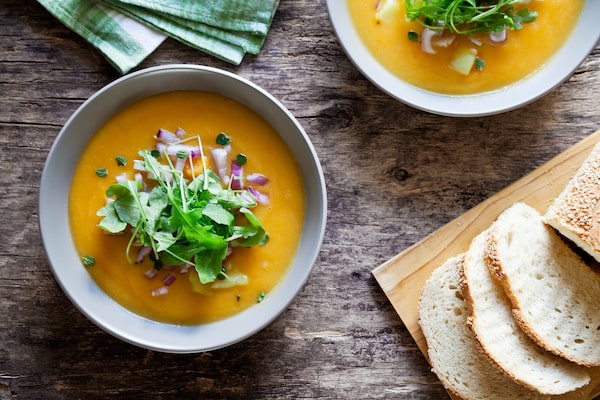
Homemade healthy vegetable soup with bread.iStock
From creamy vegetable soups to thick, rich, meaty one-pot dinners, soups are an art, and an easy one to master. You don’t need a recipe, you just need to look in your refrigerator.
Just about anything edible can be turned into soup. Think a handful of carrots and other root vegetables simmered with some curry powder and finished with cream or coconut milk, a few elderly zucchini spiked with apples and watercress, or leftover meat or sausages combined with canned white beans and canned tomatoes. Soup requires only imagination and some basics.
The one thing good soups have in common is flavourful stock – whether it is vegetable, chicken or beef. Buy low-sodium stock in Tetra Paks, “Better than Bouillon” stock pastes in jars or make your own. Stock enriches and develops the taste of soup. For tomato-based soups, use puréed canned tomatoes (preferably San Marzano) or passata (the Italian tomato purée available in bottles at the supermarket) as the stock. I thin down the tomato base with some vegetable stock (usually about 2 cups). When you want a creamy soup, do not use milk as a stock, as it will curdle when boiled. Much better to use some chicken stock and add whipping cream at the end. If your soup is not thick enough, blend a portion and stir it back in. No flavour change but the right texture.
Soups fall into different categories. Creamy soups are an elegant option for a dinner party or a good use for leftover vegetables. Hearty one-pot soups, full of vegetables and meat, are perfect with some grainy sourdough bread for winter dinners. However, the basics are always the same.
Cut your vegetables all the same size so that they cook as evenly as possible. Have some aromatics on hand, such as chopped onion, leeks or garlic. Sauté your aromatics and vegetables in butter or olive oil then add seasonings such as garlic, herbs and spices. Add your stock and simmer – don’t boil – until the vegetables are cooked but not mushy. Overcooking tends to weaken the flavour. If you are making a creamy soup, remember to add some uncooked chopped potato (about 1 cup of potato per 4 of cups liquid) at the beginning to act as a thickener when blended.
Once the vegetables are cooked, either purée or add rinsed canned beans, cooked pasta, cooked meat, sausage or fish, and simmer together until hot. It’s best to add these cooked ingredients, particularly pasta, near the end. Pasta or rice absorbs too much broth if added uncooked. If you want a creamy soup, use a lesser amount of whipping cream, rather than table or 18 per cent, as it will not curdle when boiled.
If your soup tastes bland, here are some ideas to perk it up. Salt improves a lacklustre flavour. Freshly ground pepper adds spice. A little tomato paste adds body, especially to tomato-based soups. A pinch or two of curry powder gives a background flavour to a soup. A few drops of lemon or lime juice will make your soup livelier. Herbs always help, as do soup garnishes.
In restaurants, the garnish may be so elaborate that it takes over the soup. I like to keep it simple with additions such as swirled yogurt or sour cream; a few drops of chili oil; a dusting of herbs. Mix some pesto (try using carrot tops for carrot soup and arugula for green soups) with sour or sweet cream and drizzle it around the soup. Stir fry a piece of the vegetable used in the soup and plop it on top. This is especially nice with cream soups to let diners know what kind of soup it is.
Most soups freeze well, as do leftover raw vegetables for making soup later. Soup is a healthy addition to any meal and can help to reduce food waste.
Need some advice about kitchen life and entertaining? Send your questions to lwaverman@globeandmail.com.
 Lucy Waverman
Lucy Waverman